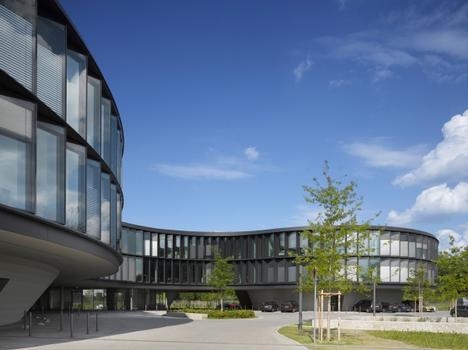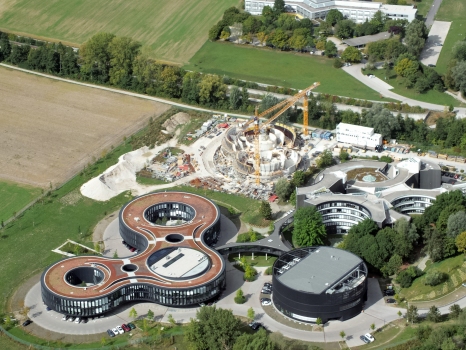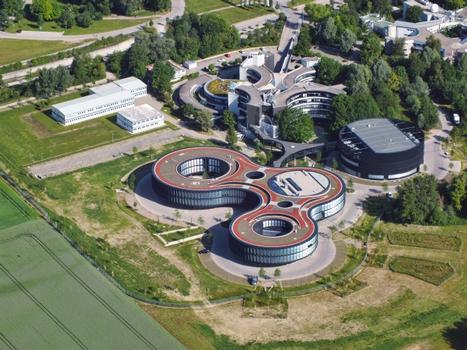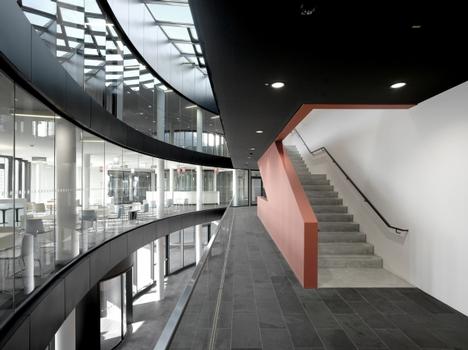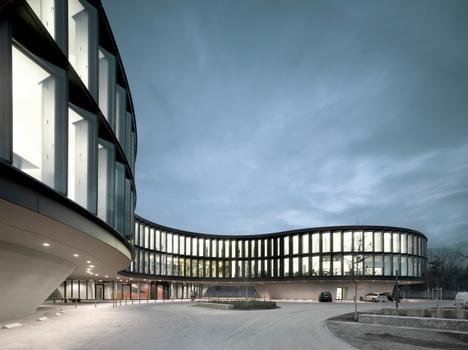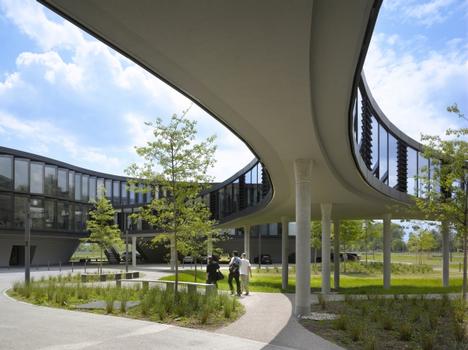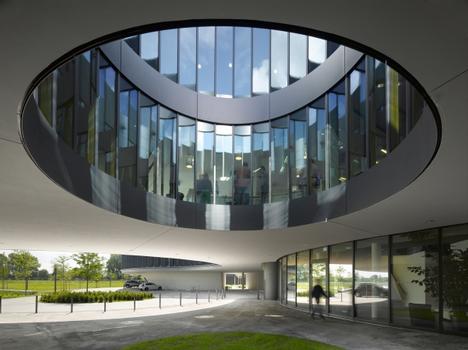General Information
| Completion: | December 2013 |
|---|---|
| Status: | in use |
Project Type
| Function / usage: |
Research institute Office building |
|---|---|
| Structure: |
Frame |
| Material: |
Reinforced concrete structure |
Awards and Distinctions
| 2015 |
entry
for registered users |
|---|
Location
| Location: |
Garching bei München, München (Kreis), Bavaria, Germany |
|---|---|
| Connects to: |
ESO Headquarters (1980)
|
| Coordinates: | 48° 15' 32.83" N 11° 40' 19.80" E |
Technical Information
Materials
| building structure |
reinforced concrete
|
|---|
Expansion of the European Southern Observatory
Task statement
ESO (European Organisation for Astronomical Research in the Southern Hemisphere) is the European organization for astronomical research in the Southern Hemisphere. It was founded in 1962 and provides European astronomers and astrophysicists with research facilities. ESO's existing headquarters, dating from the 1980s, is located at the Garching Research Center north of Munich. To accommodate the continued growth in member countries and staff, ESO's headquarters needed to be expanded with a new office and conference building and a technical building. The extension is to be connected to the old building by a connecting bridge.
The design for the ESO extension building was awarded 1st prize in an international realization competition in 2008.
Description of the main supporting structure
The new ESO office and conference building consists of three circular building sections A, B and C, connected by reinforced concrete floors. The two upper floors of the building have a two-story cantilever all around (cantilever length about 4.60m). Between buildings A / B and B / C there is a column-free area on the ground floor with a maximum span of approx. 20m. The supporting structure was designed as a reinforced concrete skeleton structure consisting of the main load-bearing elements columns (diameter 25 - 35cm), slabs (thickness h=26cm), wall-like beams (thickness d=30cm) and ribbed supporting structure above the column-free areas (rib height incl. ceiling slab 150cm, width 75cm).
The adjacent technical building was also designed as a reinforced concrete skeleton structure. The ceilings of the assembly hall, which can be expanded as a clean room, as well as the laboratory rooms are designed as ribbed ceilings.
The ribbed ceilings are also designed as ribbed ceilings.
The curved connecting bridge with reinforced concrete platform and supports features a glass superstructure with a steel frame structure as the primary supporting structure.
Choice of construction materials
- Reinforced concrete: C20/25 to C45/55
- Concrete steel: BSt 500/550 S+M
- Profiling steel: S235, S355
- Tensioning steel: St 1570/1770
- Injection piles (GEWI piles): St 500/550
Design
The two new maximum 3-story structures of the office and conference building and the technical building interpret the existing architectural language of the existing building with their circular building form. The office and conference building is elevated on the first floor and has floor-to-ceiling, transparent facades on the upper floors. The technical building is two-story with a ventilated metal façade. With its moderate height development, the building forms a gentle transition to the park landscape, which serves as a recreation area for the employees. The office and conference building is connected to the existing building and the new technical building via a bridge on the 1st floor. The office spaces are designed as cellular offices arranged in a circle around the landscaped courtyards.
The technical building is connected to the old and new office buildings via the bridge walkway on the 1st floor.
Triple insulating glazing, district heating from the geothermal power plant of Energiewerke Garching, and concrete core heating and cooling via the building's own geothermal well make the building a resource-efficient and sustainable building.
Special engineering achievement
The ESO office and conference building achieves its special feature from an engineering point of view in the structural-engineering solution of the circumferential, two-story cantilever as well as the column-free areas between the three building sections. The indented base floor creates the design impression of a building floating above the terrain. The approx. 4.6m cantilever of the upper floors is made possible by an efficient, spatial load-bearing system consisting of tension hangers, compression columns (1st floor), the floor slabs as well as bulkhead walls (2nd floor). In addition, the short-circuit of the forces over the circular floor plan geometry of the entire building is optimally utilized for load transfer. The cantilevered ceiling slab on the 1st floor is connected to the bulkhead walls of the 2nd floor positioned above it via indented tension supports at the cantilever end. The bulkhead walls, which are designed as wall-like girders, bear load internally on compression columns on the 1st floor.
The force-locking, tension/compression-resistant connection of the two floor slabs with the bulkhead walls creates a spatial load-bearing system. The overturning moment of the bulkhead walls due to cantilevering can be absorbed as a horizontal pair of forces by the two circular floor slabs and transferred to the stiffening stairwell walls.
The stairwell walls can be supported by the two circular floor slabs.
The horizontal forces in the slabs can be largely short-circuited by the circumferential cantilever with an almost symmetrical load-bearing system. Only with the force-locking connection of all load-bearing elements to each other, the three-dimensional, efficient load-bearing behavior is established.
The large spans of the column-free area between buildings A / B and B / C are made possible by a ribbed supporting structure at the roof level. The vertical loads from the slabs below are suspended upward into the ribbed structure at the roof level via bulkheads and columns at the 1st and 2nd floors, and transferred from this structure into the supporting elements of the adjacent sections of the building.
What are the positive effects of engineering?
The spatial support system achieves extremely positive effects in terms of construction, sustainability and design. Due to the spatial load-bearing effect, the load transfer of the cantilever can be distributed to all load-bearing elements. In contrast to alternative solutions (e.g. "table solution" with reinforced floor slab above ground floor or "head structure" with reinforced roof structure), this allows the design of extremely slim floor slabs (thickness 26cm) with significantly lower dead weight. With the execution of the slimmest possible slabs, not only the efficiency of the supporting structure but also the design is taken into account.
Due to the optimized cross-sections with small component dimensions, the design also represents a favorable solution from an economic point of view. Only in the production, the setup supports under the cantilever in the ground floor must remain installed until the completion of the load-bearing bulkhead walls on the 2nd floor and the roof ceiling. Otherwise, fabrication is as for conventional solid buildings.
Shape and form in this building develop from the spatial, 3-dimensional load-bearing behavior of the supporting structure and thus form an immovable unit.
The design of the ESO office and conference building represents a successful example of interdisciplinary collaboration between architecture and engineering.
Explanatory report by Mayr | Ludescher | Partner Consulting Engineers on the submission to the Ulrich Finsterwalder Ingenieurbaupreis 2015
Participants
Relevant Web Sites
There currently are no relevant websites listed.
- About this
data sheet - Structure-ID
20066627 - Published on:
01/12/2014 - Last updated on:
20/12/2016

